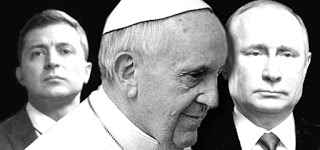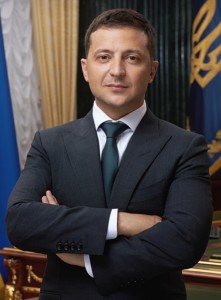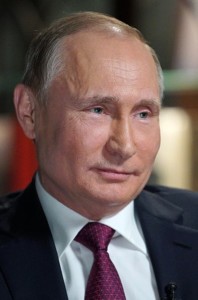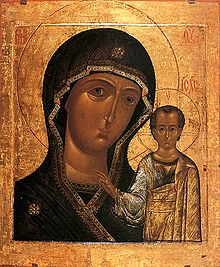


Three images related to a possible Russia-Ukraine Summit meeting in Rome with Pope Francis, in the near future, to discuss the tense situation in the Donbass region of Ukraine. Top, Pope Francis, 84, with Vladimir Putin, President of Russia, 68, and Vladimir Zelensky, President of Ukraine, 46, in the background. In the second photo, Zelensky alone, and in the third photo, Putin alone. For reports on the possible meeting, see below.
Letter #21, 2021, Wednesday, April 28: Ukraine Summit?
Pope Francis to host Putin and Zelensky in the Vatican?
Reports are circulating today that Ukrainian President Vladimir Zelensky and Russian President Vladimir Putin may be invited soon to Rome, to the Vatican, by Pope Francis, to discuss the tense and dangerous situation in the Donbass region of eastern Ukraine.
The hope would be that such talks would diminish tensions and avoid the threat of increasing bloodshed.
A conflict has been simmering in the region for weeks, with artillery shells being fired and a number of civilians being wounded and killed, and seemingly threatens to break out into open war, which might risk drawing in many other countries.
In this time after the great feast of Easter (and on the vigil of the Orthodox Easter this coming Sunday), all such efforts to arrive at agreements via dialogue and agreement, instead of through violence and brute force, seem to be deserving of support.
Delegations from our Urbi et Orbi Foundation (link) have been traveling to Russia and Ukraine since 1999 — for 22 years now.
We have been seeking to “build bridges” between Catholics and Orthodox through many common cultural projects and events, including musical concerts, and the return to Russia in 2004 of the long-lost icon of Our Lady of Kazan.
We have in the process developed many friendships in both countries, friendships which are precious to us.
In Christ, and under the protective mantle of the Virgin Mary, Mother of all Christians, we do support, and pray fervently for, any and all efforts which may lead toward deeper mutual understanding between Russia and Ukraine, and which may tend toward a just and lasting peace in the region. —RM
***
(1) A story setting forth the possibility of such a meeting, with my apologies for any deficiencies in the quick translation (link):
Zelensky: Vatican ideal place to meet Putin
(© Sputnik. Stringer, 11:49 28.04.2021)
In the context of the escalation of relations between Russia and Ukraine, the heads of state of the two countries said they were open to dialogue, with the Ukrainian president who proposed the Vatican as a neutral meeting place.
In an interview with the Italian daily la Repubblica, the President of Ukraine, Vladimir Zelensky, said that the Vatican could be the “optimal place ” for negotiations with Russia on the Donbass.
“The Holy See is a world moral authority that always acts effectively as a mediator, being impartial and credible towards all parties in conflict. This is why the Vatican has often asked for the resolution of conflicts between states for a peaceful future,” he [Zelensky] said.
Last week, the Ukrainian leader in a video message suggested to his Russian counterpart to “meet everywhere in the Ukrainian Donbass where there is war.”
Vladimir Putin replied that Kiev should first of all conduct a dialogue with the leadership of the Donetsk People’s Republic (DNR) and the Lugansk People’s Republic (LRP), but added that he is ready to receive Zelensky in Moscow if he wants to discuss a ‘bilateral agenda.
Separately, it was emphasized that neither Crimea nor Donbass will be included.
On Monday [April 26], the President of Ukraine said that everything points to the fact that the meeting with Putin will actually take place, while the time and place are only details.
The Kremlin has confirmed that the administrations of the heads of state are in constant contact.
Tensions in southeastern Ukraine have increased recently.
The self-proclaimed republics [Note: Donetsk and Lugansk, the two easternmost provinces of Ukraine, whose populations are largely Russian-speaking] blame the [Ukrainian] armed forces for all of this, and Kiev and Western countries talk about the activity of the Russian army near the borders.
Moscow has repeatedly stated that it is interested in stabilizing the situation among its neighbors, and has also specified that they will not attack anyone.
***
2) Here is a second story, published in Italy in Italian earlier today, on this topic, again in my own quick and perhaps imperfect translation (link):
WEDNESDAY 28 APRIL 2021 [so, earlier today]
Putin and Zelensky in the Vatican to discuss the Donbass with the Pope?
(RC – edited by the Editorial Staff of “Il Sismografo”):
The Kremlin responds to Zelensky’s offer on a possible meeting with Putin in the Vatican: “Moscow has not received an official offer from Ukrainian President Vladimir Zelensky to meet Russian President Vladimir Putin in Vatican.”
This (below) is what the Russian press now reports, releasing statements by Dmitrij Peskov, press officer of the Russian head of state. [Note: So, a Russian spokesman is confirming that the meeting is being “rumored,” but he also confirms that nothing about the meeting is yet official.]
“President Zelensky said this could be the perfect place for a meeting. Of course, neither the Vatican, if at this point everything is understood well, nor the Russian side have been officially informed up until now. We have not yet received any official information that this proposal has been concretized and formulated,” added Peskov, who then specified: Putin has already clearly stated “what his attitude is towards Zelensky’s initiatives. that the arguments of a possible dialogue between the two countries must concern only bilateral relations.”
The Kremlin with this formula indicates that Ukraine should speak with the self-proclaimed “People’s Republics of Donetsk and Lugansk.” [Note: Meaning, that the leadership of the provinces of Donetsk and Lugansk, in Putin’s view, should be represented in any talks about their future fate.]
Meanwhile, just today Paolo Rodari, a journalist for Repubblica.it, writes in the introduction to the interview with Cardinal Leonardo Sandri: “The Prefect of the Oriental Churches explains that any mediation by the Holy See can only take place in the wake of the work of the Minsk Accords.”
The cardinal explains that he is not aware of a possible Putin-Zelensky-Francis meeting and, however, recalls that the Pontiff is always available to support any initiative, anywhere, that fosters peace, dialogue and encounter.
***
Here is a link to more information on Zelensky, who is 43 (link).
Here is a link to more information on Putin, who is 68 (link).
[End, articles about a possible Zelensky-Putin meeting hosted by Pope Francis]
The Unitas Project
Urbi et Orbi Communications, the publisher of Inside the Vatican magazine since 1993, is about to launch our newest work worldwide: Unitas: “Come, Rebuild My Church.”
We are looking for 24 “Elders” and 153 “Founding Members” (we already have 60 of these Founding Members) to become the principal sponsors of this work, which will use every means to restore unity within the Catholic Church and to recover unity between the Catholic and Orthodox Churches.
We would particularly like to include some members of Orthodox faith.
With your support and encouragement, we will continue the work we have begun, seeking to bring Mary back to Russia, and to bring the “lux ex oriente” (“the light from the East”) back to the increasingly materialistic West.
Unitas: “Come, Rebuild My Church” will carry out initiatives to build unity — within the Catholic Church, and between the Catholic and Orthodox Churches, and in doing so between each of our souls and God one stone at a time… one living stone at a time… in the hope of the promise…
Here below is an entry in Wikipedia about the Icon of Our Lady of Kazan.
Many points are still obscure, and it may be that some points made in this Wikipedia report are not true.
However, after reading the report, I found it useful, though I cannot vouch for the truth of every statement made in it. —RM

Our Lady of Kazan
(From Wikipedia, the free encyclopedia, link)
Our Lady of Kazan, also called Mother-of-God of Kazan (Russian: Казанская Богоматерь tr. Kazanskaya Bogomater), was a holy icon of the highest stature within the Russian Orthodox Church, representing the Virgin Mary as the protector and patroness of the city of Kazan, and a palladium of all of Russia, known as the Holy Protectress of Russia.
According to legend, the icon was originally acquired from Constantinople, lost in 1438, and miraculously recovered in pristine state over 140 years later in 1579.
Two major cathedrals, the Kazan Cathedral, Moscow, and the Kazan Cathedral, St. Petersburg, are consecrated to Our Lady of Kazan, and they display copies of the icon, as do numerous churches throughout the land.
The original icon in Kazan was stolen, and likely destroyed, in 1904.
The “Fátima image” is a 16th-century copy of the icon, or possibly the 16th-century original, stolen from St. Petersburg in 1917 and purchased by F. A. Mitchell-Hedges in 1953. It was housed in Fátima, Portugal from 1970 to 1993, then in the study of Pope John Paul II in the Vatican from 1993 to 2004, when it was returned to Kazan, where it is now kept in the Kazan Monastery of the Theotokos.
Copies of the image are also venerated in the Catholic Church.
Feast days of Our Lady of Kazan are 21 July, and 4 November (which is also the Russian Day of National Unity).
History
According to tradition, the original icon of Our Lady of Kazan was brought to Russia from Constantinople in the 13th century.
After the establishment of the Khanate of Kazan (c. 1438) the icon disappeared from the historical record for more than a century.
Metropolitan Hermogenes‘ chronicle, written at the request of Tsar Feodor in 1595, describes the recovery of the icon.
According to this account, after a fire destroyed Kazan in 1579, the Virgin appeared to a 10-year-old girl, Matrona, revealing the location where the icon lay hidden.
The girl told the archbishop about the dream but she was not taken seriously.
However, on 8 July 1579, after two repetitions of the dream, the girl and her mother recovered the icon on their own, buried under a destroyed house where it had been hidden to save it from the Tatars.
Other churches were built in honor of the revelation of the Virgin of Kazan, and copies of the image were displayed at the Kazan Cathedral of Moscow (constructed in the early 17th century), at Yaroslavl, and at St. Petersburg.
Russian military commanders Dmitry Pozharsky (17th century) and Mikhail Kutuzov (19th century) credited invocation of the Virgin Mary through the icon with helping the country to repel the Polish invasion of 1612, the Swedish invasion of 1709, and Napoleon’s invasion of 1812.
The Kazan icon achieved immense popularity, and there were nine or ten separate miracle-attributed copies of the icon around Russia.
On the night of June 29, 1904, the icon was stolen from the Kazan Convent of the Theotokos in Kazan where it had been kept for centuries (the building was later blown up by the communist authorities).
Thieves apparently coveted the icon’s gold frame, which was ornamented with many valuable jewels.
Several years later, Russian police apprehended the thieves and recovered the frame.
The thieves originally declared that the icon itself had been cut to pieces and burnt, although one of them eventually confessed that it was housed in a monastery in the wilds of Siberia.
This one, however, was believed to be a fake, and the Russian police refused to investigate, using the logic that it would be very unlucky to venerate a fake icon as though it were authentic.
The Orthodox Church interpreted the disappearance of the icon as a sign of tragedies that would plague Russia after the image of the Holy Protectress of Russia had been lost.
Indeed, the Russian peasantry was wont to credit all the miseries of the Revolution of 1905, as well as Russia’s defeat in the Russo-Japanese War of 1904–1905, to the desecration of her image.
After the Russian Revolution of 1917, there was speculation that the original icon was in fact preserved in St. Petersburg.
Reportedly, an icon of Our Lady of Kazan was used in processions around Leningrad fortifications during the Siege of Leningrad (1941-1944) during World War II.[4]
Another theory proposed that the Bolsheviks had sold the image abroad, although the Russian Orthodox Church did not accept such theories.
The history of the stolen icon between 1917 and 1953 is unknown.
In 1953 Frederick Mitchell-Hedges purchased an icon from Arthur Hillman.
Although the status of the icon as the original Kazan icon remained disputed, Cyril G.E. Bunt concluded “that it is the work of a great icon painter of the 16th century […] the pigments and the wood of the panel are perfectly preserved as exhaustive X-ray tests have proved, and have mellowed with age”, suggesting that while it was a copy of the original icon, it was nevertheless the original icon carried by Pozharski in 1612.
It was exhibited at the World Trade Fair in New York in 1964–1965.
On 13 September 1965, members of the Blue Army of Our Lady of Fátima spent the night in veneration of the icon in the pavilion in New York.
The Blue Army eventually bought the icon from Anna Mitchell-Hedges for US$125,000 in January 1970, and the icon was enshrined in Fátima, Portugal.
In 1993 the icon from Fátima was given to the Vatican and Pope John Paul II had it installed in his study, where he venerated it for eleven years.
In his own words, “it has found a home with me and has accompanied my daily service to the Church with its motherly gaze.”
John Paul II wished to visit Moscow or Kazan so that he himself could return the icon to the Russian Orthodox Church.
However the Moscow Patriarchate was suspicious that the Pope might have other motives, so he presented the icon to the Russian Church unconditionally in August 2004.
On August 26, 2004, it was exhibited for veneration on the altar of St. Peter’s Basilica and then delivered to Moscow.
On the next feast day of the holy icon, July 21, 2005, Patriarch Alexius II and Mintimer Shaymiev, the president of Tatarstan, received it in the Annunciation Cathedral of the Kazan Kremlin.
The icon is now enshrined in the Cathedral of the Elevation of the Holy Cross, part of the Convent of the Theotokos (re-established as a monastery in 2005), on the site where the original icon of Our Lady of Kazan was found, and plans are underway to make the monastery’s other buildings into an international pilgrimage centre.
[End, Wikipedia article]
***
Note: Russian Orthodox Patriarch Kirill is expected to consecrate the new Kazan Cathedral in three months, on July 21, 2021.






Facebook Comments